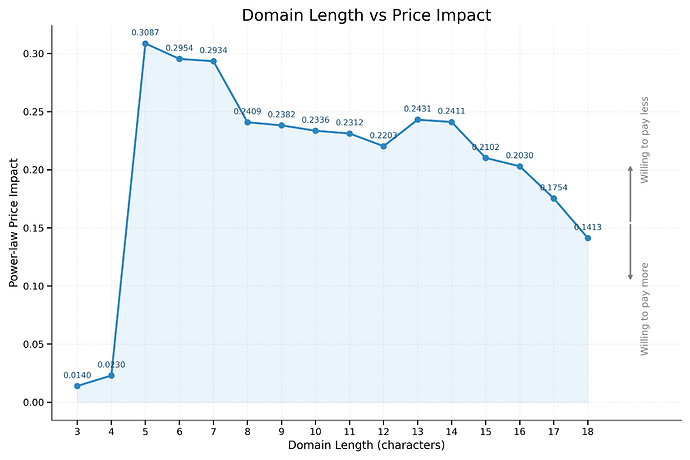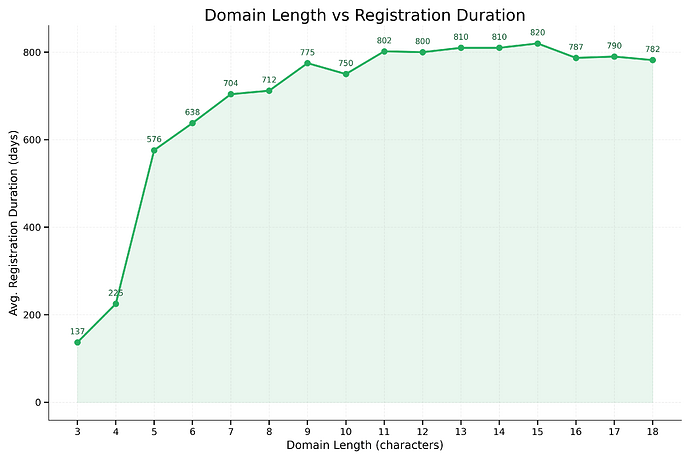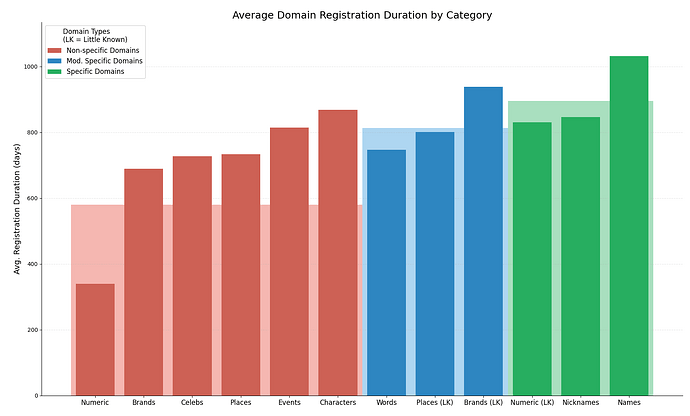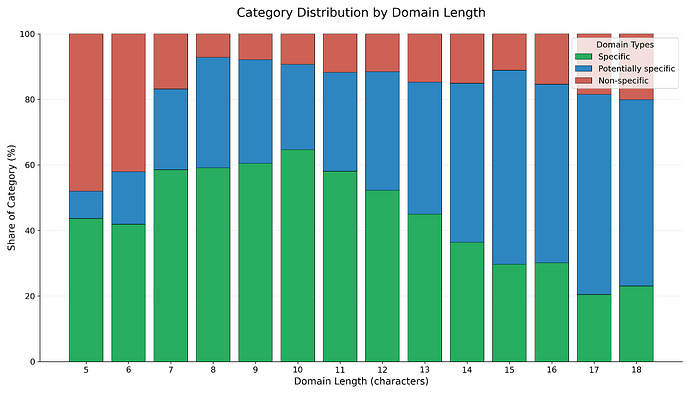I did some additional research to explore splitting the 5L+ category into two subgroups with different prices to keep them affordable. I studied how user behavior differs within this broad 5L+ group and found a rationale for dividing it into 5–7L and 8L+ subcategories, which I will describe below.
Price Sensitivity
On the price impact graph for domains of different lengths, you can see a rather unexpected econometric picture. Price sensitivity almost continuously decreases with increasing number of characters. It would be expected the opposite, because 5L have a much more limited supply than, for example, 18L.
5-7L domains are essentially the most sensitive and vulnerable to high gas (and to the final price, respectively). That is, seeing high gas, a user is more likely to abandon the idea of registering a domain “danch.eth” than “alexnetto.eth”.
Does this mean that 5-7L domains should cost less than 8L+? From a purely economic point of view, yes. However, firstly, this does not correspond to the established pricing logic of “shorter – more expensive”. Secondly, one more anomaly can be noticed: in the 8-12L section there is a certain pit, which tells us that in such a large 5L+ category there is a certain complex structure with its own patterns.
Registration Duration
As for the average selected registration duration, we can again note the presence of a certain rule: at the point 9L, the duration increases sharply and then remains in approximately the same range of 800 days.
As noted in previous posts, the registration duration is the most reliable metric for classifying a user as a regular or a speculator. However, if we divide users into those with 1-3 domains (and mark them as regular) and those with 4 or more (and mark them as speculators), as we did earlier, we will find that their ratio is the same for all domain lengths longer than 5 – about 32%.
This means that we can assume that in the 5-7L (or 5-8L) section, there are many regular users who nevertheless register domains with some speculative interest. They register domains that have no particular value now, but they expect that such value will appear in the future.
Domain categories
To know this for sure, it is necessary to estimate the “potential virality” of domains of different lengths that are registered. I manually went through several tens of thousands of randomly selected names and identified three categories of encountered domains by specificity level.
1.Non-specific domains. Those that may be of interest to a wide range of people and have high speculative potential. These include:
-
Actual or modified names of popular brands that are not publicly known to have registered a domain. For example, chevrolet.eth or walmartrewards.eth.
-
Actual or modified names of celebrities that are not publicly known to have registered a domain. For example, richard-branson.eth or stephencurrynft.eth.
-
Names of fictional characters from famous works. For example, walter-white.eth.
-
Names of countries, cities, or world-famous places. For example, brooklyn-bridge.eth.
-
Names of any media or historical events. For example, civilwar.eth.
-
Numeric or numeric-like. For example, 41512.eth or 333th.eth.
2.Moderately specific domains. All domains “on the edge” that could, in theory, be of interest to a limited number of people. This includes:
-
Names of real, but little-known brands. For example, baysidebarbers.eth is the name of a Canadian barbershop.
-
Names of locally famous places. For example, cameronhighlands.eth is the name of a district in Malaysia.
-
Words or combinations of words that could well be used by a specific person as a nickname, but will also likely be of interest to other people. For example, digitalmillionaire.eth.
3.Specific domains. Those that are highly likely to be valuable to only one person/organization. This includes:
-
Personal names, not associated with celebrities. For example, stephanedelecroix.eth is the name of a French software engineer.
-
Nicknames/usernames, especially if it can be found on the Internet. For example, mengmeng123.eth.
-
Numeric domains that imitate a phone number or an eventless date. For example, 19940506.eth.
As you can see, the distinction is rather arbitrary. There could be two people in the world who use the nickname Mengmeng123 or have the name Stephane Delecroix. However, due to the large sample size, I believe that the output is approximately accurate.
In the graph above, you can see what average registration duration is chosen for each domain category. The data once again shows that regular users (who register a domain specific only to them) choose long registrations.
This graph shows how specificity is distributed by domain length.
In the 5-6L area, there are a large number of domains from the non-specific category. Mainly due to the numeric domains included in the potential 100k and 1mil clubs, which are known to be in low demand at the moment. In 7L, a large number of nicknames are already appearing, but they are still flooded with smaller numeric domains imitating smaller dimensional domains (for example, 0x69420.eth).
From 8L to 12L, nicknames dominate, and we can say that this is the area filled with the most specificity. Apparently, such a length is chosen as a nickname not only in ENS (here is a study on the lengths of Reddit nicknames).
In 13L+, the number of nicknames decreases, and personal names begin to replace them in the specific group. The group with moderate specificity comes to the fore, mainly due to word combinations.
With a small caveat, the obtained data can explain the anomaly in price sensitivity. For some reason, people registering their nickname as a domain are willing to pay more than for a domain that does not personally relate to them. Despite the fact that they are willing to pay more, I propose introducing a “softer” curve for them, so that this category of users, which is presumably the main driver of adoption, can always register a domain at a more affordable price.
Recommendations
The updated recommendation would be to split the 5L+ category into 5-7L and 8L+. For 8L+, I recommend using a curve with a starting point of $10 and an asymptote of $3. There will be no specific continuous formula, but the decay will be as follows:
Year 1 - $10 (avg. $10/y);
Year 2 - $7.5 (avg. $8.75/y);
Year 3 - $6 (avg. $7.8/y);
Year 4 - $5 (avg. $7.125/y);
Year 5 - $4.5 (avg. $6.6/y);
Year 6 - $4 (avg. $6.15/y);
Year 7 - $3.6 (avg. $5.8/y);
Year 8 – $3.4 (avg. $5.5/y);
Year 9 – $3.2 (avg. $5.25/y);
Year 10 – $3 (avg. $5/y);
Then $3 for each subsequent year.
Based on the curvature calculation (more details in the original post), we can expect that with such a price curve, users will choose an average of 8 years of registration. Registrations are not expected to decrease, however, the long-term income of ENS for this category of domains will not increase (however, the income “here and now” will increase).
At the same time, the user will have the opportunity to average the price to about $ 5 dollars if they choose an 8-year registration. Registering a domain for a period longer than 10 years will allow you to get the domain at your disposal for an average price less than the current fixed price.
Recommendations for other lengths remain unchanged, only the curve that was previously proposed for the entire 5L+ is now proposed for 5-7L:
- For 3L domains: $ 640 for the first year, $ 430 for the second year, $ 360 for the third, and so on according to the formula P (t) = 420 / t + 220.
- For 4L domains: $ 160 for the first year, $ 107.5 for the second year, $ 80 for the third, and so on according to the formula P(t) = 105/t + 55.
- For 5-7L domains: $15 for the first year, $10 for the second year, $8.33 for the third, and so on according to the formula P(t) = 10/t + 5.



